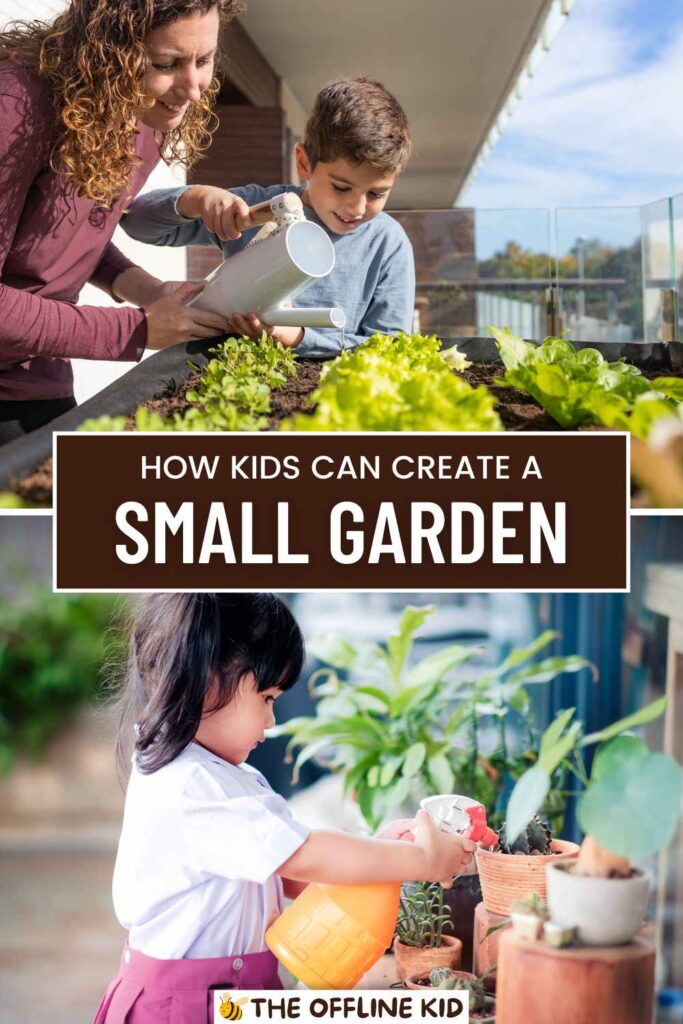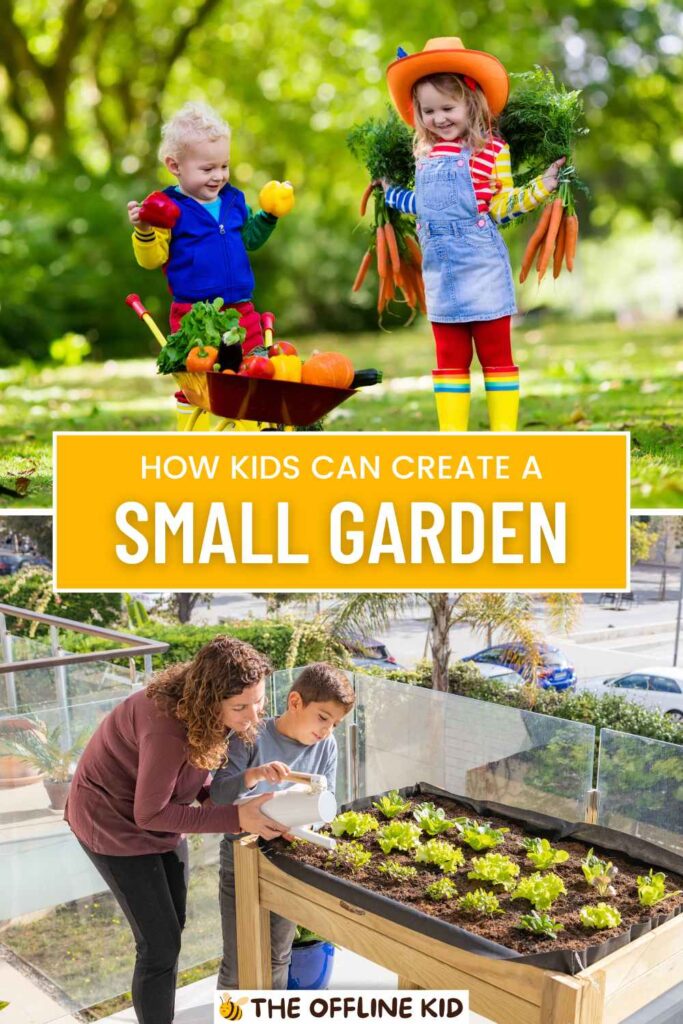Gardening with kids is a rewarding experience that combines fun and education.
This guide will walk you through every step of creating a small garden, from planning to harvesting, ensuring a delightful and fruitful gardening journey with your little ones.
Planning Your Garden
Gardening success starts with good planning, especially when involving kids.
Let’s break down the essential steps to create a fun and manageable garden project for your family.
Choosing the Right Location For Your Small Garden
Sunlight Requirements
- Full Sun: Most vegetables and flowers need 6-8 hours of direct sunlight daily.
- Partial Shade: Some plants, like lettuce and spinach, can thrive in less sunlight.
- Accessibility for Kids: Ensure the garden is easy for kids to reach and navigate. A spot close to the house can make watering and checking on plants more convenient.
Deciding What to Grow
Easy-to-Grow Plants for Beginners
- Vegetables: Cherry tomatoes, radishes, carrots, peas
- Flowers: Sunflowers, marigolds, nasturtiums
- Herbs: Basil, mint, parsley
Considering Kid-Friendly Plants
- Fast-Growing: Plants like radishes and sunflowers show quick results, keeping kids interested.
- Sensory Plants: Choose plants that engage multiple senses, such as fragrant herbs, colorful flowers, and interesting textures.
Creating a Garden Plan
Layout and Design
- Raised Beds vs. In-Ground Beds: Raised beds can be easier to manage and prevent soil compaction from little feet.
- Using Containers: Great for small spaces and can be moved around easily.
- Paths and Borders: Create clear pathways to avoid trampling plants. Use stones, mulch, or stepping stones for paths.
Tools and Materials Needed
- Basic Tools: Kid-sized gloves, trowels, watering cans, and rakes.
- Materials: Soil, compost, seeds or seedlings, plant markers, and garden bed materials (wood for raised beds or pots for container gardening).
Tips for Planning with Kids
- Involve Them in Decision-Making: Let kids help choose plants and design the garden layout. This ownership increases their interest and enthusiasm.
- Keep It Simple: Start small to avoid overwhelming them (and yourself). You can always expand next season.
- Safety First: Choose safe, non-toxic plants and avoid thorny or spiky varieties. Ensure tools are age-appropriate and safe for children to use.
By taking the time to plan carefully, you set the stage for a successful and enjoyable gardening experience.
With the right location, thoughtful plant choices, and a clear small garden plan, your family is ready to embark on a fun and educational gardening adventure!
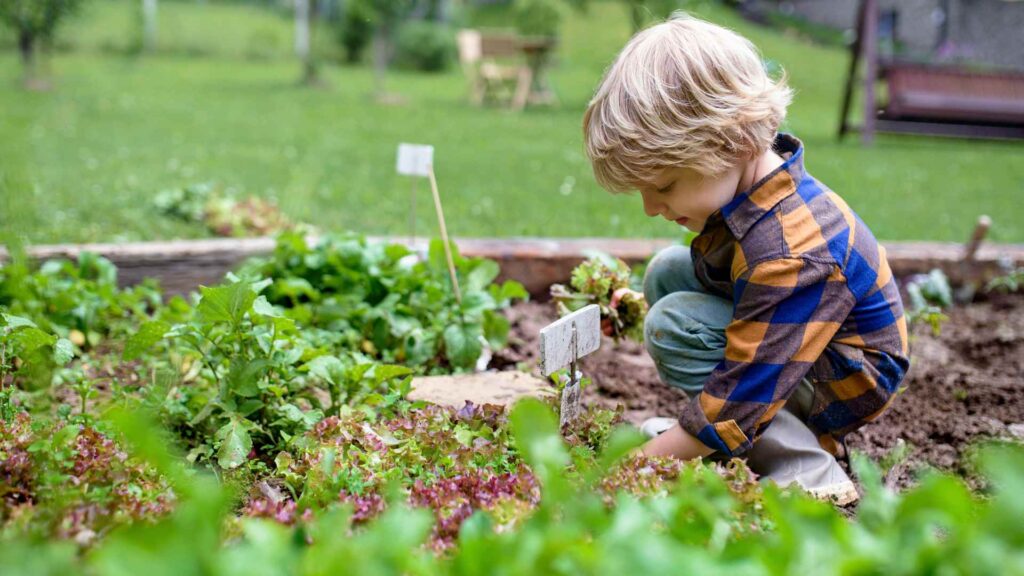
Preparing the Garden
Once your plan is in place, it’s time to prepare the garden. This involves getting the soil ready, setting up the garden beds, and ensuring everything is safe and accessible for your little gardeners.
Soil Preparation
Importance of Good Soil
- Nutrient-Rich Soil: Healthy soil is the foundation of a thriving garden. It provides essential nutrients for plant growth.
- Drainage: Well-draining soil prevents waterlogging, which can harm plant roots.
Testing and Amending Soil
- Soil Testing: Test your soil’s pH and nutrient levels using a home test kit or through a local extension service.
- Amendments: Add compost, aged manure, or other organic matter to improve soil structure and fertility. Explain to kids how compost enriches the soil and recycles organic waste.
Setting Up Garden Beds
Raised Beds vs. In-Ground Beds
- Raised Beds: These are great for controlling soil quality, improving drainage, and reducing back strain. They can also help keep out pests.
- In-Ground Beds: More traditional and can be easier to start with if you’re working with an existing garden space.
Using Containers
- Versatility: Containers are perfect for small spaces, balconies, or patios. They can be moved around to catch more sunlight or protect from harsh weather.
- Variety: Use different sizes and types of containers to add visual interest and accommodate various plants.
Creating Kid-Friendly Beds
- Height: Ensure beds are low enough for kids to reach and work comfortably.
- Width: Keep beds narrow enough so kids can reach the center from either side, typically no wider than 3-4 feet.
Garden Safety
Kid-Safe Tools and Practices
- Tools: Use kid-sized tools with blunt edges. Avoid sharp or heavy equipment.
- Supervision: Always supervise young children while they are using garden tools.
- Education: Teach kids how to use tools properly and safely.
Allergies and Plant Safety
- Identifying Allergies: Be aware of any plant-related allergies your children might have.
- Safe Plants: Choose non-toxic plants and avoid those with thorns or irritating sap.
- Protective Gear: Encourage kids to wear gloves and long sleeves to protect their skin.
By preparing the garden properly, you create a safe and nurturing environment for your plants and your children.
This stage is all about laying a strong foundation that will support your garden’s growth and success throughout the season. Plus, it’s a great opportunity to teach kids about soil health, plant needs, and the importance of safety in the garden.
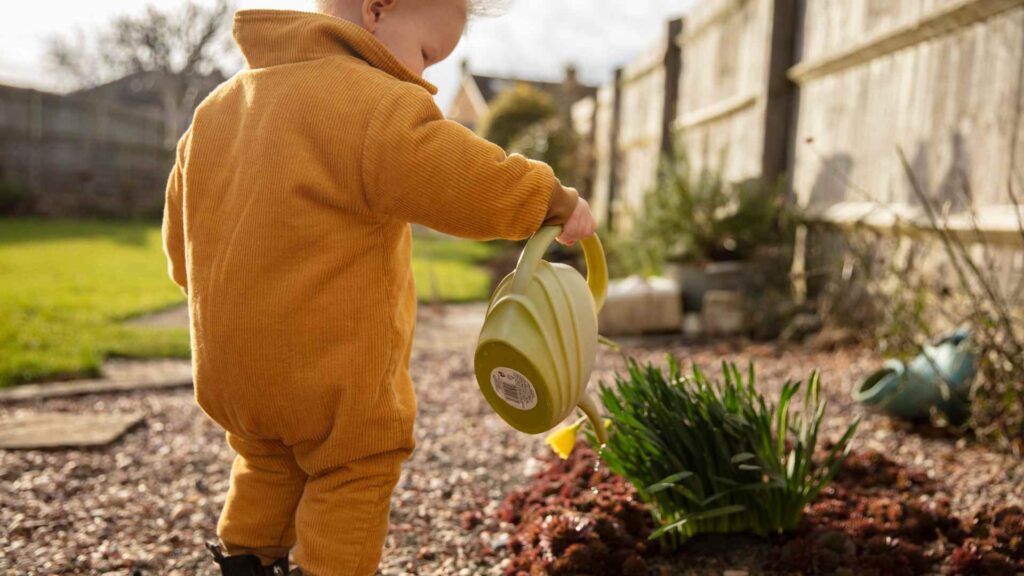
Planting the Seeds and Seedlings
Now that your garden is prepared, it’s time to plant! This section will guide you through selecting seeds, planting them, and caring for young seedlings.
Seed Selection and Germination
Starting Seeds Indoors vs. Direct Sowing
- Starting Indoors: Some plants, like tomatoes and peppers, benefit from an early start indoors. Use seed trays or small pots filled with seed-starting mix.
- Direct Sowing: Others, like beans and radishes, can be sown directly into the garden bed. Follow the instructions on the seed packet for depth and spacing.
Teaching Kids About Seed Life Cycle
- Stages of Growth: Explain the stages from seed to sprout to mature plant. Use drawings or diagrams to illustrate.
- Hands-On Learning: Let kids help with planting seeds, watering, and watching for the first sprouts. This hands-on experience is both educational and exciting.
Transplanting Seedlings
How to Handle Young Plants
- Gentle Touch: Teach kids to handle seedlings gently to avoid damaging delicate roots and stems.
- Preparation: Before transplanting, harden off seedlings by gradually exposing them to outdoor conditions over a week.
Spacing and Depth Guidelines
- Proper Spacing: Follow the recommended spacing on seed packets or plant labels to ensure each plant has enough room to grow.
- Planting Depth: Plant seedlings at the same depth they were in their pots, or slightly deeper if they have long stems.
Labeling and Mapping Your Garden
Creative Labeling Ideas for Kids
- DIY Labels: Make plant labels using popsicle sticks, rocks, or recycled materials. Let kids decorate and write the plant names.
- Waterproof Markers: Use waterproof markers to ensure labels last through the season.
Keeping Track of Planting Dates
- Garden Journal: Start a garden journal to record planting dates, growth observations, and any notes on care. This can be a fun project for kids to take charge of.
- Garden Map: Create a map of your garden showing where each plant is located. This helps kids remember what’s planted where and can be a useful reference throughout the season.
Planting seeds and seedlings is a magical part of gardening that allows kids to see life sprout from the soil.
By involving them in every step, from selecting seeds to labeling plants, you instill a sense of responsibility and wonder in your young gardeners. This foundational experience sets the stage for a season of growth, learning, and family bonding.
Caring for Your Garden
Once your seeds and seedlings are in the ground, the real fun begins. Caring for your garden involves daily activities that teach kids about responsibility, patience, and the joys of nurturing life. Here’s how to keep your garden thriving.
Watering
How Much and How Often
- General Guidelines: Most plants need about 1 inch of water per week, either from rain or watering. Adjust based on weather and plant needs.
- Consistency: Water deeply and consistently to encourage strong root growth. Avoid shallow, frequent watering which can lead to weak roots.
Kid-Friendly Watering Techniques
- Small Watering Cans: Use kid-sized watering cans that are easy for children to handle.
- Watering Schedule: Create a watering schedule and let kids take turns being the “Watering Captain” for the day.
- Fun with Sprinklers: On hot days, use a gentle sprinkler and let kids run through it while watering the garden.
Weeding
Identifying Weeds vs. Plants
- Learning to Identify: Teach kids to recognize common weeds and differentiate them from your garden plants. Use pictures or a garden guide.
- Regular Weeding: Encourage regular weeding sessions to prevent weeds from taking over. Make it a game to see who can pull the most weeds.
Safe Weeding Practices for Kids
- Hand Weeding: Show kids how to pull weeds by hand, grabbing at the base to get the roots.
- Weeding Tools: Provide small, kid-friendly weeding tools if necessary. Always supervise to ensure safety.
Fertilizing
Natural and Kid-Safe Fertilizers
- Compost: Use compost to enrich the soil naturally. Teach kids how compost is made and why it’s beneficial.
- Organic Fertilizers: Choose organic fertilizers that are safe for kids to handle and apply. Explain the importance of feeding plants.
Frequency and Application Methods
- Regular Feeding: Follow the instructions on your fertilizer for how often to apply. Typically, every 4-6 weeks during the growing season.
- Application Techniques: Show kids how to mix and apply fertilizers properly, avoiding direct contact with plant leaves to prevent burning.
Pest Control
Natural Pest Repellents
- Companion Planting: Use companion planting to deter pests. For example, marigolds can repel nematodes and certain insects.
- DIY Solutions: Make kid-safe pest repellents, such as a mixture of water, mild soap, and garlic, to spray on plants.
Involving Kids in Pest Control
- Observation: Teach kids to observe plants regularly for signs of pests, such as holes in leaves or sticky residue.
- Hand-Picking: For larger pests like caterpillars, show kids how to gently remove them by hand and relocate them away from the garden.
- Beneficial Insects: Educate kids about beneficial insects like ladybugs and spiders that help control pests naturally.
Caring for a garden teaches kids valuable lessons in responsibility and observation. Regular watering, weeding, fertilizing, and pest control are essential tasks that, when shared with kids, turn into fun and educational activities.
These daily routines not only ensure a healthy garden but also foster a deep connection between children and the natural world.
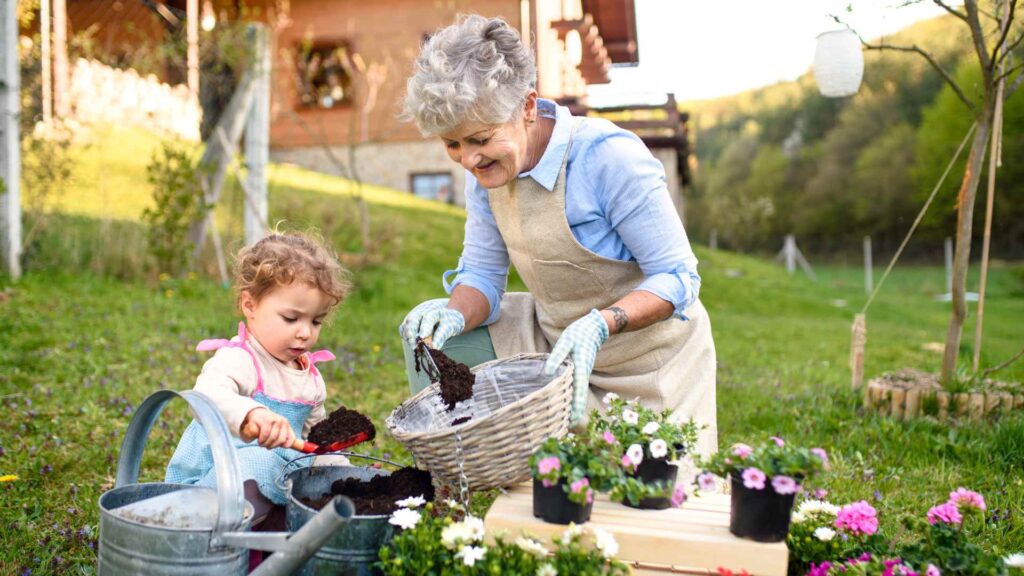
Watching Your Garden Grow
As your garden starts to flourish, there’s much to observe and learn.
This phase is filled with excitement as plants grow, flowers bloom, and produce ripens. Here’s how to make the most of this period with your kids.
Tracking Plant Growth
Keeping a Garden Journal
- Daily or Weekly Entries: Encourage kids to make regular entries in a garden journal. They can draw pictures, write observations, or take photos.
- Measuring Growth: Use a ruler or measuring tape to track the height of plants and record the data. This is a great way to incorporate basic math skills.
Measuring and Recording Growth
- Growth Charts: Create growth charts for each plant type to visualize progress over time.
- Comparing Growth Rates: Discuss why some plants grow faster than others and what factors might affect growth.
Observing Wildlife
Beneficial Insects and Birds
- Pollinators: Teach kids about the importance of pollinators like bees and butterflies. Explain how they help plants produce fruits and seeds.
- Predators: Introduce beneficial predators like ladybugs and spiders that keep pest populations in check.
Creating a Kid-Friendly Wildlife Habitat
- Insect Hotels: Build or buy insect hotels to attract beneficial insects.
- Bird Feeders and Baths: Set up bird feeders and baths to attract birds that can help control pests and add beauty to your garden.
- Butterfly Gardens: Plant flowers that attract butterflies, such as milkweed and lavender.
Engaging in Science Experiments
Growth Experiments
- Sunlight and Water: Conduct experiments to show how different amounts of sunlight and water affect plant growth. Use control and variable groups for comparison.
- Soil Types: Test how different soil types (sand, clay, loam) impact plant health and growth.
Observation and Hypothesis
- Daily Observations: Make daily observations and encourage kids to hypothesize about what they see. Why are some plants taller? Why do certain insects visit specific plants?
- Recording Data: Keep detailed records of experiments in the garden journal. Compare results and discuss findings.
Watching the garden grow is a dynamic and rewarding experience that keeps kids engaged and curious. By tracking growth, observing wildlife, and conducting simple science experiments, children gain a deeper understanding of the natural world and the interdependence of living organisms.
This phase transforms the garden into an outdoor classroom where learning is hands-on and continuous.
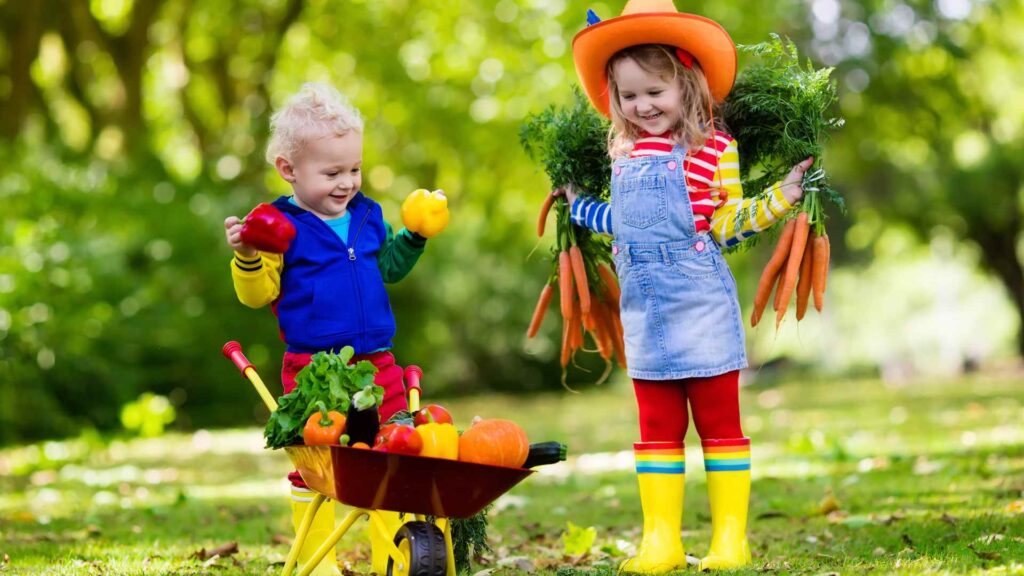
Harvesting and Enjoying the Fruits of Your Labor
Harvest time is one of the most exciting parts of gardening, especially for kids. This is when all the hard work pays off, and you get to enjoy the fruits (and vegetables) of your labor.
Here’s how to make the most of this rewarding phase.
When and How to Harvest
Signs of Ripeness
- Vegetables: Show kids how to tell when vegetables are ready to pick. For example, tomatoes should be fully red, and carrots should have a robust color.
- Fruits: Fruits like strawberries and blueberries are ripe when they are fully colored and easy to pull off the plant.
- Herbs: Herbs can be harvested once they have enough leaves. Teach kids to pick them just above a leaf node to encourage more growth.
Safe Harvesting Techniques for Kids
- Gentle Picking: Teach kids to handle plants gently to avoid damaging them. Use two hands when picking fruits or vegetables—one to hold the stem and one to pick.
- Tools: Provide kid-safe scissors or pruners for harvesting. Always supervise their use to ensure safety.
Cooking and Eating Your Produce
Simple Recipes Kids Can Help With
- Salads: Create simple salads with lettuce, tomatoes, cucumbers, and herbs from the garden. Kids can help wash and chop the vegetables.
- Smoothies: Blend garden-fresh fruits and vegetables into delicious smoothies. Let kids choose their favorite combinations.
- Pizza: Make homemade pizzas topped with garden veggies. Kids can spread sauce, sprinkle cheese, and add their favorite toppings.
Enjoying Raw Garden Snacks
- Fresh Snacks: Encourage kids to enjoy raw vegetables like cherry tomatoes, snap peas, and carrots straight from the garden.
- Herb Tasting: Have a herb-tasting session where kids can sample different herbs and learn about their flavors.
Preserving Your Harvest
Kid-Friendly Preservation Methods
- Freezing: Freeze surplus fruits and vegetables for later use. Teach kids how to wash, chop, and store produce in freezer bags.
- Drying: Dry herbs by hanging them in a warm, dry place. Once dried, kids can crumble them into jars for future cooking.
- Pickling: Make quick pickles with cucumbers, carrots, or other vegetables. Kids can help prepare the brine and pack the jars.
Creative Uses for Harvested Produce
- Craft Projects: Use dried flowers and herbs for craft projects like making potpourri or decorating cards.
- Gifts: Create homemade garden gifts like herb sachets, dried flower arrangements, or jars of pickles to share with friends and family.
Harvesting is a joyful and educational experience that brings the gardening journey full circle.
By teaching kids when and how to harvest, involving them in cooking and eating the produce, and exploring preservation methods, you help them appreciate the full cycle of plant growth and the rewards of their efforts.
This phase emphasizes the importance of patience, care, and the delight of enjoying homegrown food.
Learning Through Gardening
Gardening is not only fun but also a rich source of learning opportunities for kids.
It combines hands-on activities with educational lessons, helping children develop a wide range of skills and knowledge.
Educational Opportunities
Science and Nature Lessons
- Plant Biology: Teach kids about the parts of a plant (roots, stems, leaves, flowers) and their functions. Use real plants from the garden to show these parts up close.
- Photosynthesis: Explain the process of photosynthesis in simple terms—how plants use sunlight, water, and carbon dioxide to make food and grow.
- Life Cycles: Observe and document the life cycle of plants from seed to harvest. Discuss the different stages and what plants need at each stage.
Math and Measuring Activities
- Measuring Growth: Use rulers or measuring tapes to track plant growth. Record measurements in a garden journal and create charts or graphs.
- Counting and Sorting: Count the number of leaves, flowers, or fruits on plants. Sort seeds by size, shape, or color.
- Estimating and Comparing: Estimate the number of tomatoes on a plant and then count to see how close the estimate was. Compare the sizes of different vegetables.
Creative Projects
Garden Art and Crafts
- Decorative Plant Markers: Make plant markers using painted rocks, popsicle sticks, or clay. Let kids decorate and personalize them.
- Pressed Flowers: Press flowers and leaves from the garden to create bookmarks, cards, or framed art. This activity combines creativity with botanical learning.
- Nature Journals: Encourage kids to draw or paint pictures of plants, flowers, and garden scenes in a nature journal. They can also write about their observations and experiences.
Storytelling and Writing Inspired by the Garden
- Garden Stories: Create stories about the garden, featuring plants and animals as characters. Kids can write, illustrate, and share their stories.
- Plant Diaries: Have kids keep a diary for a specific plant, documenting its growth, changes, and any interesting events. This helps improve writing skills and attention to detail.
- Poetry: Write poems inspired by the garden. Encourage kids to use descriptive language and explore different types of poetry, such as haiku or acrostic poems.
Community and Environmental Awareness
Community Gardening
- Collaborative Projects: Participate in community garden projects or start a small garden at a local school or community center. This teaches kids about teamwork and community involvement.
- Sharing the Harvest: Donate extra produce to local food banks or neighbors. Discuss the importance of sharing and helping others.
Environmental Stewardship
- Composting: Start a compost bin to recycle garden waste and kitchen scraps. Teach kids about the benefits of composting and how it reduces waste.
- Water Conservation: Discuss the importance of conserving water and demonstrate water-saving techniques like mulching and using a rain barrel.
- Pollinator Gardens: Create a pollinator-friendly garden with plants that attract bees, butterflies, and other beneficial insects. Talk about the role of pollinators in the ecosystem.
Learning through gardening is a dynamic and multifaceted experience that engages kids in science, math, creativity, and community involvement.
By integrating educational activities and creative projects into your gardening routine, you provide a rich, hands-on learning environment that fosters curiosity, creativity, and a sense of responsibility toward the natural world.
Reflecting and Planning for Next Season
As the gardening season comes to a close, it’s important to reflect on your experiences and plan for the future.
This helps kids understand the continuous cycle of gardening and prepares them for an even more successful garden next year.
Reviewing Your Garden Successes and Challenges
What Worked Well
- Successful Plants: Identify which plants thrived and produced well. Discuss why they might have done so well (good soil, proper watering, ideal weather).
- Favorite Activities: Ask kids which gardening activities they enjoyed the most. This could be planting, watering, harvesting, or observing insects.
- Memorable Moments: Reflect on any special moments or discoveries in the garden. These could be finding a particularly interesting bug, seeing the first flowers bloom, or enjoying a fresh garden snack.
Areas for Improvement
- Plants that Struggled: Note any plants that didn’t do well and brainstorm possible reasons (too much/little sunlight, poor soil, pests).
- Challenges Faced: Discuss any challenges you encountered, such as weather extremes, pest infestations, or diseases. Talk about how you managed these issues and what you might do differently next time.
- Gardening Techniques: Evaluate your gardening methods and practices. Were there tools or techniques that could be improved or replaced?
Planning for the Next Season
Rotating Crops
- Why Rotate Crops: Explain the benefits of crop rotation, such as reducing soil-borne diseases and improving soil fertility.
- Planning the Layout: Plan a new garden layout for the next season, ensuring different types of plants are grown in different areas than before.
Expanding Your Garden
- Adding New Plants: Consider trying new varieties of plants that you didn’t grow this year. Let kids choose some new plants they’re interested in.
- Increasing Garden Space: If space allows, think about expanding your garden area. This could mean adding another raised bed, extending existing beds, or incorporating more containers.
Preparing for Winter
- Winterizing Your Garden: Discuss steps to prepare the garden for winter, such as cleaning up plant debris, adding mulch, and protecting perennial plants.
- Indoor Gardening Projects: Plan some indoor gardening activities for the colder months, like growing herbs on the windowsill or starting seeds indoors for early spring planting.
Setting Goals
- Garden Goals: Set specific goals for next season’s garden. These could include growing a new type of plant, increasing the harvest, or improving soil health.
- Skill Development: Identify any new gardening skills or knowledge areas you want to focus on, such as composting, pest management, or advanced planting techniques.
Reflecting on the past season and planning for the next helps kids see gardening as a continuous and evolving process.
It reinforces the idea that learning from successes and challenges is a vital part of any activity. By setting goals and making plans for the future, you keep the excitement and anticipation alive, ensuring that each gardening season builds on the experiences of the last.
This process fosters a sense of accomplishment and encourages a lifelong love of gardening.
